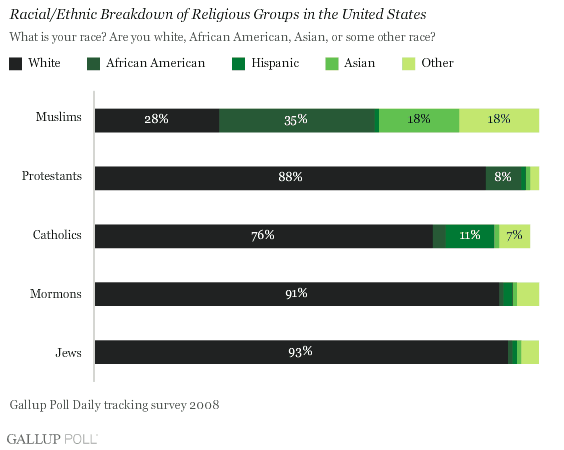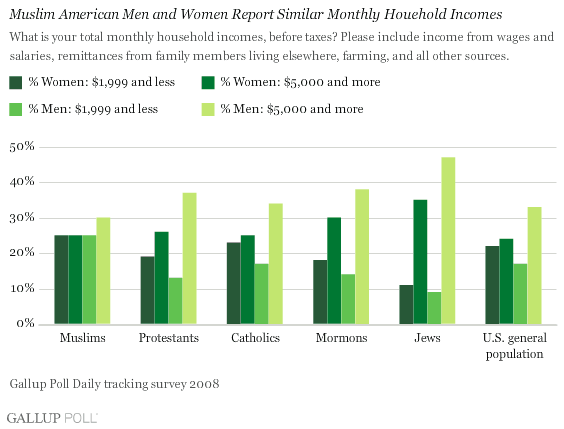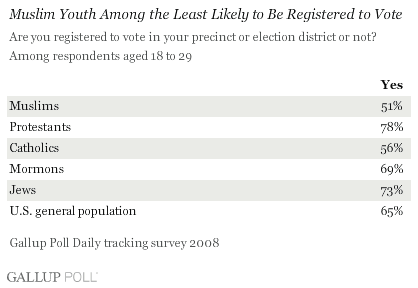WASHINGTON, D.C. -- In the first-ever nationally representative study of a randomly selected sample of Muslim Americans, Gallup reveals that Muslim Americans are the most racially diverse religious group surveyed in the United States, with African Americans making up the largest contingent within the population, at 35%.

This finding is one of many in Gallup's report, Muslim Americans: A National Portrait, which compares the opinions of Muslim Americans with those of the general U.S. population, revealing important differences in terms of gender equality, civic engagement, life evaluation, religiosity, and more.
Gender Equality
The report also reveals that Muslim American women are one of the most highly educated female religious groups in the United States, second only to Jewish American women. In addition, as a group, Muslim Americans have the highest degree of economic gender parity at the high and low ends of the income spectrum.

Muslim American women are equally as likely as men to say they attend mosque at least once a week, which stands in sharp contrast to the trend seen in some predominantly Muslim countries where men are more likely than women to report attending a religious service in the last week.
Civic Engagement Among Young Muslim Americans
The report also examines the views of Muslim American youths (aged 18 to 29) and how their levels of civic engagement compare with those of young Americans of other religious backgrounds. For example, the report finds that only 51% of young Muslim Americans are registered to vote, which is one of the lowest percentages among young Americans surveyed.

When asked about their political views, 39% of young Muslim Americans describe their views as moderate, 28% say they are either liberal or very liberal, while 20% consider themselves politically conservative or very conservative.
Life Evaluation
Gallup asked Americans across religious groups to evaluate their lives as well as their expectations of where they think they will be in five years using the Cantril Self-Anchoring Striving Scale with steps numbered from 0 to 10, where "0" indicates the worst possible life and "10" indicates the best possible life. Americans classified as "thriving" say that they presently stand on step 7 or higher of the ladder and expect to stand on step 8 or higher about five years from now. The 41% of Muslim Americans considered to be "thriving" is the lowest percentage among religious groups studied.

However, when comparing percentage of "thriving" Muslim Americans with Muslims in other Western societies as well as those in predominantly Muslim countries, Muslim Americans are among the groups with the largest percentage of respondents who say they are thriving. (Of the predominantly Muslim countries surveyed, only Saudi Arabia's population has a similarly high proportion of thriving individuals.)
Religiosity
Concerning faith and religiosity, about 41% of Muslim Americans and Protestant Americans say they attend their place of worship at least once a week, while 37% of Catholic Americans say the same. When asked whether religion is an important part of their daily lives, 80% of Muslim Americans answer in the affirmative. Of the religious groups studied, only Mormons (85%) are more likely than Muslims to say religion plays an important role in their lives.

More About the Report
Muslim Americans: A National Portrait reports key findings and in-depth analysis geared at informing the discourse about Muslim Americans. The Gallup Center for Muslim Studies conducted the study as part of its Muslim West Facts project to explore Muslim Americans' attitudes on issues ranging from emotional well-being, political views, the economy, and the importance of faith in the lives of Muslims living in America. This groundbreaking report sheds light on the Muslim thread of the American tapestry: a community that is frequently discussed, but often misunderstood. It captures the nuances of a Muslim American population that, although facing its equal share of challenges, remains a largely untapped resource of American talent.
Survey Methods
Results are based on daily cell phone and landline phone interviews with more than 300,000 adults, aged 18 and older, in the United States in 2008. Of the total sample, 946 respondents self-identified themselves as Muslims. For results based on the total sample, one can say with 95% confidence that the maximum margin of sampling error is ±0.2 percentage points. For results based on the sample of 946 Muslim Americans, the maximum margin of sampling error is ±4 adjusted for design effect. In addition to sampling error, question wording and practical difficulties in conducting surveys can introduce error or bias into the findings of public opinion polls.

